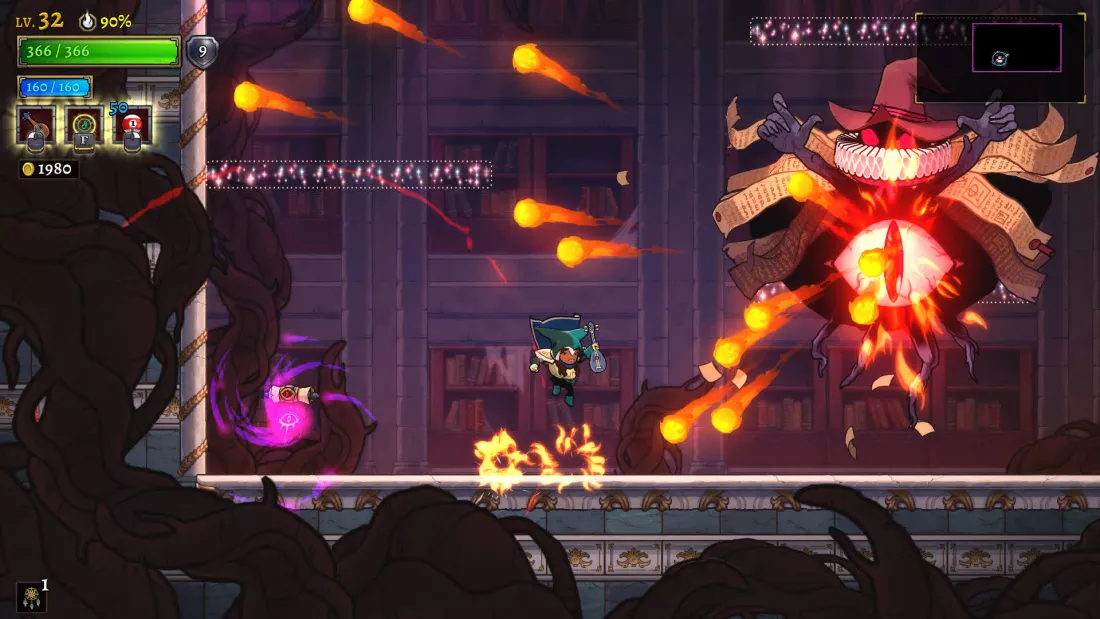Back in 2013, the original Rogue Legacy revolutionized the roguelike formula by allowing players to spend currency on permanent upgrades instead of losing everything upon death. This innovation birthed the roguelite subgenre, inspiring standout titles like Hades, Returnal, and Dead Cells. Nearly a decade later, Rogue Legacy 2 enters a crowded landscape, yet it wisely opts not to reinvent the wheel. Instead, it modernizes its visuals, premise, and mechanics to meet contemporary gaming standards, refining the design to perfection.
Rogue Legacy 2 feels like a reimagining of the original, benefiting from the evolution of the genre. The core concept remains strong: you control a hero with a randomized name, class, and quirky trait as you explore a sprawling, procedurally generated castle, collect loot, and face bosses. When you die, you lose your progress from that run (except for defeated bosses or unlocked portals), but you can spend your loot on various permanent upgrades that carry over to your next character.
While the foundation is familiar, every aspect of the game has been improved. Each of the 13 classes now has unique weapons, talents, passive abilities, and stats, leading to distinct playstyles. For instance, my favorite class, the Valkyrie, wields a large polearm that allows for multi-directional attacks and can deflect projectiles to replenish mana. In contrast, the Barbarian swings a slow but powerful axe, excelling in aerial spins for devastating damage.
What’s particularly exciting is the introduction of skill crits, which offer each class a specific way to achieve critical hits through skilled play. For some characters, it’s as simple as attacking while dashing; for others, it involves precise timing or positioning. This not only differentiates the classes further but also rewards players who invest time in mastering them.
I always looked forward to playing as the Valkyrie, but I never felt frustrated when assigned a class I was less familiar with. Each class presents its own strengths and weaknesses, making it enjoyable to adapt to different playstyles.
In addition to class variability, each character can have a random trait that may be beneficial or detrimental. These traits are often based on real-life conditions; for example, you might have a character with colorblindness that plays in monochrome or one prone to panic attacks, which darkens the screen when hit. While some traits are fun and add variety, others can become tedious. The more challenging ones, like the pacifism trait, prevent you from dealing damage but offer gold bonuses, though I rarely found the trade-off worth it.
Never a Wasted Run
While the expanded class system is impressive, what truly sets Rogue Legacy 2 apart is its expansive, interconnected world. With six unique locations compared to the original’s four, each area presents distinct challenges. One area features horizontal gameplay with tricky arrow traps, while another emphasizes precise vertical platforming. A third location resembles a labyrinth with low visibility, requiring players to use landmarks to navigate.
Progression is gated by powerful bosses and special artifacts called heirlooms, which grant permanent upgrades that enhance exploration and combat—such as double jumping or dashing mid-air. Each heirloom comes with a tutorial that effectively teaches players how to use these new abilities, ensuring they’re well-prepared for platforming challenges and hidden secrets.
Beyond heirlooms, players can find a plethora of relics that offer significant buffs or risky trade-offs, influenced by a Resolve stat that limits the number of relics you can equip without sacrificing health. Weapons, spells, and blueprints for future runs add further depth to the gameplay, allowing for customization that aligns with individual playstyles.
What I love most about Rogue Legacy 2 is that every run feels meaningful. Even if you don’t defeat a boss or unlock an heirloom, you’re likely to discover new blueprints, gather gold for upgrades, experiment with different classes, or learn valuable lessons about enemy tactics. If you have a short run, it’s often because the character simply wasn’t meant for a longer journey.
Coming Back Stronger
Despite the wealth of choices for upgrading your character between runs, the multitude of decisions can be overwhelming. It’s easy to make poor choices regarding permanent upgrades, leaving your save file in a tough spot. After purchasing 15 upgrades, subsequent upgrades become increasingly expensive, which can stifle progress.
I faced a significant roadblock in my first playthrough by spreading my points too thin while expanding my manor to explore different upgrades. While this approach allowed me to experiment with various classes, my stats became underleveled for the more challenging areas. Consequently, I struggled to survive long enough to gather loot for meaningful upgrades. The result was a sluggish grind in the late game, diminishing the initial excitement of progression. I wish there were an option to reset manor upgrades to recover from such missteps.
The good news is that by learning from my experience, you can avoid similar pitfalls. Rogue Legacy 2 offers a robust and rewarding experience, ensuring that every run contributes to your growth as a player.


